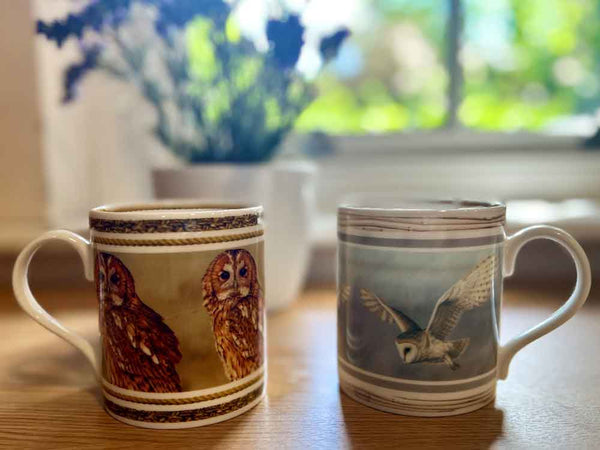Falco Tinnunculus

If you see a medium-sized brown bird hovering above a roadside, chances are its a kestrel. Also known as a 'windhover', a kestrel's ability to hang suspended in the air as it pinpoints its prey is unique among birds of prey.
Identifying a kestrel
Male and female kestrels are quite distinct. The male has blue-grey feathers on its head and tail and chestnut-brown feathers on its back, whilst the female's feathers are brown. An adult female sports dark bars across its tail, whilst an adult male has an all grey tail with a deep black band at its base. Both birds have yellow feet, a yellow rim around their eyes, and a trim of yellow skin above their beaks.
Juvenile kestrels
Fledgling kestrels are brown and it is only possible to tell the difference between the sexes from about four weeks old when a male will begin to show a hint of grey in its tail. It's not until the bird reaches a year old that the male's head starts to grow blue-grey feathers. Its tail will remain heavily barred until it is at least two to three years old, then the barring on a male's tail begins to lessen and it develops one deep black bar at the base of its tail. 

Kestrel food
Kestrels mainly eat voles but will also take wood mice and shrews, small birds, insects and earthworms. They have keen eyesight and can spot prey from 50m away. Kestrels need to eat 4-8 voles a day, depending on the time of the year. They have a habit of catching several voles in succession and caching some for later. The stored food is usually eaten the same day just before dusk. This reduces the risk that the bird would have to go to roost on an empty stomach.
Kestrel flight
When a kestrel's flight is level its tail looks very long and its wings are pointed. If it spots a potential meal it hovers with its tail fanned out and pointing down to keep it stable. It keeps its head motionless as it pinpoints its prey and drops height in stages, like a descending lift, until finally it folds its wings to drop and pounce, grasping its prey with its talons.
Kestrel courtship
Although kestrels mature when they are a year old, many do not manage to secure a mate and a breeding territory until their second year. Kestrels begin their courtship in the cold winter months to ensure that their bond is secure before the breeding season begins. Pairs usually mate for life. I have known males to have more than one mate in a season, although this is unusual.
Click here to read about the time I discovered the kestrel in my garden had a mistress & was raising two families at once.
Kestrel nest
Kestrels will nest in tree cavities and disused crows nests, but they can be persuaded to settle in to nest boxes. They do not build a nest but will scrape a small dent into the debris lining the bottom of the nest and lay their eggs here.
Kestrel eggs
The timing of egg-laying is dependent on the weather, but a female kestrel normally lays her clutch of 3-6 eggs in late April or early May. This year was relatively mild so she has laid much earlier. A female kestrel is also only able to produce eggs if she can get enough food. In years when vole numbers are low, many kestrels fail to nest at all. This year, thankfully, vole numbers have been high. The female lays speckled, brown eggs at two-day intervals
Incubation
The female usually starts to incubate as she lays the third egg and incubation takes 27-29 days per egg. Once the eggs are laid the male also takes turns incubating the eggs. These then hatch over a period of a few days. The chicks require constant brooding for the first 10-14 days, after which they are able to control their own body temperature. During this time the male provides the female and the chicks with food and in fact the female will only hunt if food is short since she risks losing her eggs or young chicks if she leaves them. Only as the young get bigger, can she safely start to hunt close to the nest.
Last year the kestrels at Fotherdale actually lost their mother during this crucial period. Click here to read how they were rescued
Kestrel chicks
The chicks are covered in a white downy feathers when they hatch. They fledge gradually when they are around four weeks old and will explore increasing distances from the nest, but return to it to roost for another couple of weeks. Adults continue to feed the young for a month after fledging, during which time they will learn to catch their own food.

Unusually for birds of prey, there is no aggression between the chicks, which tend to fly, perch and roost together even for some time after fledging. In the autumn, kestrels readjust their territories to make best use of winter food supply. In good vole habitat, kestrels tend to stay within their home ranges throughout the autumn and winter, while elsewhere many move to areas with a better winter food supply. The size of the winter territory is dependent on food supply and the number of other kestrels, but is at least 1 km square. Although it is defended, neighbouring territories sometimes overlap.
Kestrel old age
Kestrels can live to a ripe old age and there are records of one that lived 24 years. Kes, the wild kestrel that lived in my garden was roughly 12 years old when he disappeared. As they age their feathers begin to turn grey especially in their tails. This causes confusion between younger males and aging females.
My kestrel paintings


Kestrel | Limited Edition Print | Available Here

















1 comment
[…] Click here for help with your kestrel ID […]